
The Griquas Today

Le Fleur (the Griqua Reformer)
| The origin of Andries Stockenstrom Le Fleur (the
Reformer's) name (according to Griqua Legend)
The Reformer's father was guide and bodyguard to Sir Andries Stockenström, Lieutenant-General of the Eastern Province. According to Griqua legend, Abraham one day saved Stockenström's life while he was being attacked by a band of Xhosas. Afterwards Stockenström said to Abraham: "You are a brave man. One day, when you have a son, you must name him after me. Take this five pound note; it must be used to christen the boy; if he turns out to be a coward, you must beat him to death, because a brave man like you does not deserve a coward for a son." Abraham le Fleur called his first son Thomas Lodewyk. When his second son was born, he named the boy after himself and Stockenström, thereby fulfilling God's revelation to him that this was the fulfillment of Stockenström's prophecy. |
In the section below you will discover that the Griqua people are now, once again, over a century later close to gaining some lands back. (Our thanks to Louis Nel for this information)
Image Right: John de Bruin
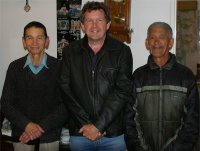 (75) Scott Balson and Cecil de Bruin (82). John is the
Griqua headman at Kokstad - his role has no political bearing today with
the Griqua leadership now intricately tied up with the Griqua National
Church.
(75) Scott Balson and Cecil de Bruin (82). John is the
Griqua headman at Kokstad - his role has no political bearing today with
the Griqua leadership now intricately tied up with the Griqua National
Church.
In 1927, The Reformer (Andrew Andries Stockenstrom Le Fleur) led the last trek of Griqua people from Kokstad. People from Elandsdrif (Cradock), Trompsburg, Louisvale, etc. joined this trek. These people were originally settled at Keurvlakte (Nature's Valley), where they established themselves as fishermen and farmers. This trek was to play an important role in the eventual settlement of Griqua people from across the country in that area.
In 1939 The Reformer started negotiations with a farmer, a certain Van Rooyen, for hiring parts of a farm, Kranshoek, for use by the Griqua people and a site for his burial at Robberg in the future. His son, Thomas le Fleur, continued the negotiations after his death. At that time, The Reformer lived on a farm called Jakkalskraal, close to Kranshoek.
The Reformer died in a house adjacent to the site of his tomb at Robberg on 11 June 1941. It is still a regular place of pilgrimage for the Griqua people of South Africa. After his death, his eldest son Abraham Le Fleur succeeded him as leader of the Griqua people.
Plettenberg Bay and Springbok region:
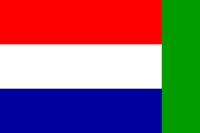
In the early 1900s the Griqua community adopted a flag. The flag is the inverse of the Transvaal vierkleur, that is, the Dutch tricolour is next to the hoist and the vertical green panel is along the outside edge of the fly. (see image right)
Comments from Louis Nel (received 19th January 2005):
It would interest you to know that the Griqua, under the banner of the Griqua National Conference of South Africa (established by AAS le Fleur I after his release from the Breakwater Prison at 15:00 on 3 April 1903) have succeeded in two land claims in the now Western Cape Province, namely the farm Jakkalskraal outside Plettenberg Bay and the Farm Ratelsgat, (previously called Luiperdskop) outside Vanrhynsdorp at Luiperdskop, near Cape West Coast on the N7 to Springbok. The main concentration of Griquas is at Krantzhoek near Plettenberg Bay.
Attached please find a copy of the text (word doc - about 100k) I wrote for an exhibition of the provincial museum services on AAS le Fleur I. This was done in celebration of the centennial celebration of his release from the Breakwater Prison. Due to limitations on the number of words I could use it is at best an overview, but I hope it will at least give you some new information. The text was written in collaboration with the GNC and approved by them. The past being something that seems to change more often than the present I would only go as far as to say that the text represents the Griqua version of his life.
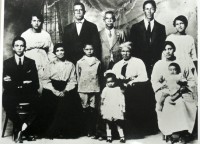 Image right, left to right::
Image right, left to right::
Back row: Dorothea le Fleur, Paramount Chief AAS le Fleur I, Lodewyk
Kok, Abrahan le Fleur, Annie le Fleur.
Front: Adam Johannes le Fleur, Annie Kok, Thomas Lodewyk le Fleur,
Rachel Susanna le Fleur, Charlotte le Fleur
Young children: Charlotte le Fleur (standing) and AAS le Fleur II
(sitting on Charlotte's lap).
As an example I may mention Le Fleur's "capture" and subsequent sentencing. In almost all reference books I studied while preparing for the assignment it is claimed that he was captured after either having been hunted down or captured by a Xhosa chief and then handed over to the authorities. The so-called rebellion was, according to the Griquas nothing more that a meeting to discuss the land claims matter that Le Fleur had pursued rather actively. The Griqua burghers were armed with no more than quince sticks. After their first skirmish with the authorities Le Fleur himself urged his followers to hand themselves over.
Today AAS le Fleur is often referred to as "die kneg" or "servant of God" by the Griquas.
The Griqua Reserve near Vanrhynsdorp on the Cape West Coast:
For the Griqua, historical links with the area designated for the Knersvlakte Biosphere Reserve date back to 1916 when a forefather of Paramount Chief AAS le Fleur I (known as Die Kneg) settled in the district and lived at Ratelsgat. Several Griqua leaders are buried on the farm, a place that holds great value for the Griqua for whom it is part of a prophecy that, they, as the descendants of Adam Kok, will be brought together as a nation.
The proposed Knersvlakte Biosphere Reserve comprises different zones with the core zone being “wilderness” where no development, farming or business infrastructures are allowed. Zone 2 allows grazing of animals and business developments. The Griqua farm, Luiperskop, is currently inside the core wilderness zone, but the Griquas want to develop tourism facilities that highlight the Griqua culture. They have recommended that either the Luiperskop farm be isolated from the core area or the reserve be rezoned to make their farm the gateway to the reserve with the entrance sited on their land together with the structures proposed in the Griqua Ratelsgat Tourism Development Project.
Issues still need to be resolved between West Cape Nature Conservation and the Knersvlakte District Municipality, but the Griqua National Conference (GNC), as legitimate owners of Luiperskop, are confident that the Mareesberg District Municipality are considering them seriously. In terms of the Environmental Impact Assessment, they have listed the GNC as a Category 1 Stakeholder.
More on the Griqua revival at this link
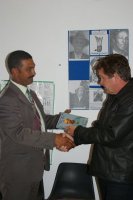 The new national paramount chief of the Griqua nation was
inaugurated yesterday at a solemn, yet celebratory ceremony in Kranshoek
near Plettenberg Bay. Alan Andrew le Fleur, 37, succeeds his late father,
Abraham Andrew Stockenstrom le Fleur II, (The Reformer) who died in July
aged 81. He is the fourth-generation Le Fleur to take on the role of traditional
leader. Dignitaries and guests joined more than 1 000 Griquas to witness
the religious and traditional proceedings.
The new national paramount chief of the Griqua nation was
inaugurated yesterday at a solemn, yet celebratory ceremony in Kranshoek
near Plettenberg Bay. Alan Andrew le Fleur, 37, succeeds his late father,
Abraham Andrew Stockenstrom le Fleur II, (The Reformer) who died in July
aged 81. He is the fourth-generation Le Fleur to take on the role of traditional
leader. Dignitaries and guests joined more than 1 000 Griquas to witness
the religious and traditional proceedings.
Image right: Scott Balson meets Alan le Fleur at Kranshoek
Rituals included the handing over of traditional Griqua symbols, including a staff, a Christian bible, the Griqua flag and a copy of the Griqua constitution. Community elders also laid hands on the shoulders of Le Fleur to symbolise the responsibilities of the nation passed onto him. The Griqua National Conference, the foremen who guided the Griquas for the past few months since Abraham le Fleur’s death, also verbally handed authority to their new leader.
In his inaugural speech, Le Fleur said he would build on the foundations of his ancestors, but he would be geared towards the demands of a new era.
“I will not do everything like my father did as I am a leader in my own right. I am looking towards a future where urgent discussions with leaders on local, regional and national level need to take place,” he said.
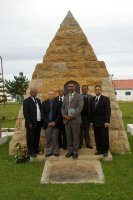 Le Fleur appealed to Western Cape Premier Ebrahim Rasool
to raise awareness of the needs of Griquas to premiers of other provinces.
“I also encourage Griquas in other parts of the country to make themselves
heard through local government structures. Get involved in uplifting the
nation.”
Le Fleur appealed to Western Cape Premier Ebrahim Rasool
to raise awareness of the needs of Griquas to premiers of other provinces.
“I also encourage Griquas in other parts of the country to make themselves
heard through local government structures. Get involved in uplifting the
nation.”
Image right: Alan le Fleur with his elders at the monument in Kranshoek to Abraham Andrew Stockenstrom le Fleur II
Rasool said the Western Cape desperately needed good leaders who could play a role in unifying the diverse cultures, backgrounds and communities of the province.
“We need traditional leaders such as yourself to walk into a new era of transformation,” he said.
Bitou mayor Euan Wildeman welcomed Le Fleur into the fold of leaders in the Western Cape.
“It is important to recognise traditional leaders as the pillars of South African society and we are committed to support paramount chief Le Fleur in the fight against issues that affect us all – poverty and job creation.”
The inauguration is regarded a special occasion, since most Griquas (descendants from the Khoisan) may witness this ceremony only once in their lifetime. The last inauguration was in 1953.
The Griqua cultural experience at Ratelgat
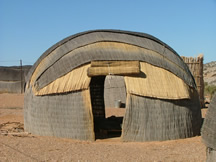 For
those people who have a real interest in Griqua culture and who would like
to directly support the people who have made such a large, but often hidden,
contribution to the history of South Africa there is now the opportunity
to do so.
For
those people who have a real interest in Griqua culture and who would like
to directly support the people who have made such a large, but often hidden,
contribution to the history of South Africa there is now the opportunity
to do so.
Image right: One of 28 modified traditional huts now available to tourists..
With the help of the South African Government the Griqua National Conference has established a tourist resort which is unlike any other in the world today. The Ratelgat experience is on traditional Griqua lands in the Nama Karoo near Vredendal well north of Cape Town. This dry, parched area teams with life and fascinating drought-resistant plants and reflects just a small part of the amazing heritage that the Griquas bring to the Rainbow Nation.
The resort. once complete, will offer traditional Griqua culture in a large amphitheatre, a Griqua museum and modern units as well as the more traditionally styled Griqua huts pictured above right.
The Ratelgat project offers comfortable accommodation and a rich cultural expereince, its objectives being:
to regroup the Griqua community.
to redevelop and conserve the rich Griqua culture and heritage with Ratelgat as a focal point.
to develop the farm in such a manner that the unique cultural-and eco experience can be shared by the broader community.
to provide cultural and tourism facilities which will enable the Griqua community to become part of the main stream economy (Tourism study completed).
to ensure training and create temporary and permanent job opportunities for the Griqua community and especially women and the youth.
to ensure a sustainable project through proper planning, training, capacity building and implementation.
Ratelgat now forms part of the Balson Holdings Family Trust's Global Village Homestay cultural tourism project. More at this link.
MPEGs - original video/audio
clips - please note the size of these files - Griquas
speak Afrikaans!
 Please wait
for video clips to load
Please wait
for video clips to load
The Griqua National Anthem - web page with words and video link (just 4.5 mByte)
The view from the hazardous Ongeluksnek (just over 2 mByte)
A Griqua describes the trek down the Ongeluksnek Pass (13 mByte)
The Hanging Tree at Griqua Town - Nicholas Waterboer explains (6.2 mByte)
A talented Griqua story teller describes a hanging (8.5 mByte)
A Griqua minstrel sings a song (9 mByte)
Griqua story tellers discuss Griqua fables (10 mByte)
The Griquas and their Church at Campbell (6 mByte)
*A Griqua story teller, Wilim Adam, at his best, discusses "the amusing speeding bicycle and the cow event" (about 20 mByte)
* Scott Balson met Wilim Adam (seen right) in 2007 - the story teller, then 102, was celebrating his birthday at the Bergmanshoogte township near Philippolis.
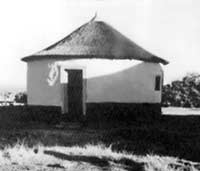
Nelson Mandela, the man who brought the people of South Africa out of their nightmarish existence under apartheid was born in the region once known as Nomansland.
Image right: The house at Qunu in the Umtata district in which Nelson Mandela was born.
As Mandela states in his autobiography: I was born in Umtata, Transkei, on 18 July 1918. My father, Chief Henry, was a polygamist with four wives. Neither he nor my mother ever went to school. My father died in 1930, after which David Dalindyebo, then acting Paramount Chief of the tribe, became my guardian.
The
Nelson Mandela Museum is located at
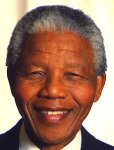 Qunu - a small clusted of villages
surrounded by open veld and rolling hills. It was in this environment that
the young Mandela grew up as a herd boy. It was here that Mandela says he
was happiest, woken in the morning by the cock crowing, exploring the countryside
as he drove his small flock of sheep and cattle and paddling in the Qunu
River.
Qunu - a small clusted of villages
surrounded by open veld and rolling hills. It was in this environment that
the young Mandela grew up as a herd boy. It was here that Mandela says he
was happiest, woken in the morning by the cock crowing, exploring the countryside
as he drove his small flock of sheep and cattle and paddling in the Qunu
River.
It is clear, from Mandela's features (image right) that he has Khoi-Khoi (Griqua) blood running through his veins...
Nelson Mandela said: "Actually people like
Harry the Strandloper whose real name was Outarmiyo (sp) he was one of the
first freedom fighters to go to Robben Island. I addressed a meeting of coloured
intellectuals in Pretoria when I was President. A retired teacher said “we
know why you are so close to the coloured people, because you are a coloured
yourself”.
Full
transcript at this link
|
God, eeuwig groot en goed
|
Scott Balson with Alan le Fleur at Kranshoek in 2007 |
The brass discs around his neck
Made a jangling sound
Cadenced as his calloused feet
Struck the dusty ground
Running down from Kokstad
Along to Strachan`s store
To trade them in for maize and cloth
Tobacco, sugar, more!
"Kence" the money of the Griquas
Passed from hand to hand
Legal tender for all debts
Incurred in Nomansland
And what an empire Strachan built
On his brass token coins
From Mountain Home to Umzimkulu
They graced the people's loins.
Fifty years they traveled round
For whatever was bought and sold
The tokens of Strachan`s store…
Redeemed as good as gold!
Today they turn up now and then
Uncommon and quite rare
Strachan`s tokens of East Griqualand
The money once used there!
by Rege James Podraza
Rege Podraza's web site is at this link
S Balson "Children of the Mist - the
lost tribe of South Africa" (2007)
S Balson "The Griquas of
South Africa and their Money" (2004)
Rev W Dower's book:
"The Early Annals
of Kokstad and East Griqualand" (1902) - reprint available from Killie
Campbell Library (University of Natal) 1978
S Balson and C Graham's book
"Kence, the trade
tokens of Strachan and Co" (1978)
Donald Moodie: "The
Cape Records relative to the condition and treatment of the native tribes
of South Africa from an inquiry" (1841)
Rev John Campbell's books
"Travels in South
Africa" (1822)
William Ten Rhyne and Henry Secreta Zevorzit's
book: "An Account
of the Cape of Good Hope and the Hottentotes, the Natives of that
Country" (1673) - by (translated into English from Latin in 1704)
Clifton C Crais's book
"White Supremacy
and Black Resistance in pre-Industrial South Africa" (1992)
John Shephard's book:
"In the shadow
of the Drakensberg" (1976)
Alf Wannenburg's book:
"Forgotten
Frontiersmen"
S J Halford's book:
"The Griquas of
Griqualand" (Mr. S.J. Halford was the the Mayor of Kokstad in 1923
- he built the Dutch Reformed Church in Kokstad)
R Harber's book:
"Gentlemen of Brave
Mettle" (1975)
A F Hattersley's book "More Annals of
Natal" (1936)
Robert Ross' book:
"Adam Kok's Griquas"
(1976)
The Griqua National Council - and Louis Nel for recent developments on the Griquas